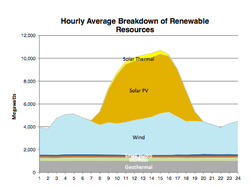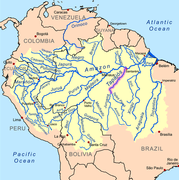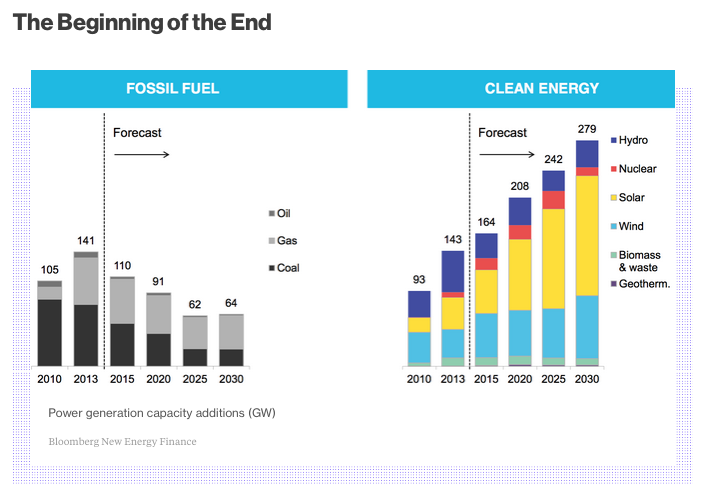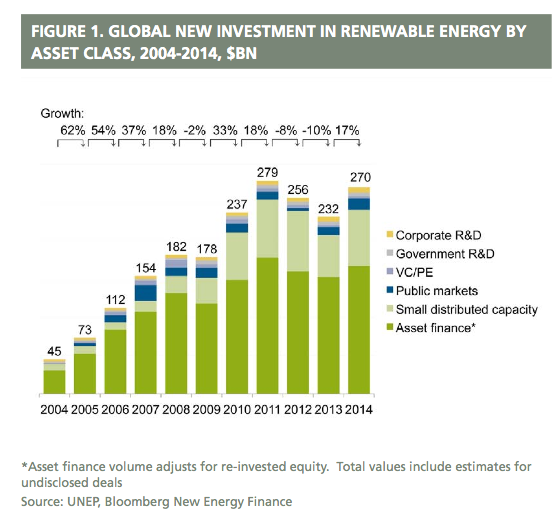

|
|
 Brazil's National Economic Policy Council recently eliminated state and federal government taxes on power generated from small-scale renewables, according to Bloomberg New Energy Finance's Week in Review. The move is expected to encourage homeowners and small businesses to generate electricity from renewables such as rooftop solar. The country’s energy regulator, ANEEL, estimates rooftop solar in Brazil could reach 2GW of capacity by 2024 if all states agree to drop the tax.
 In remarks at the Bloomberg New Energy Finance summit, Michael Picker, president of the California Public Utilities Commission, said that in California “We could get to 100 percent renewables." “Getting to 50 percent is not really a challenge,” according to Picker. He said the grid already is comfortably managing solar and wind energy that reached as much as 40 percent of the total a few days last year. New analysis by Bloomberg New Energy Finance finds that the world is now adding more capacity for renewable power each year than coal, natural gas, and oil combined.
Renewable energy investment surged 17% to $270 billion in 2014. Further, the world added 103GW of new renewable power capacity (excluding large hydro), and renewable energy technologies made up 48% of net power capacity added globally, according to Global Trends in Renewable Energy Investments 2015, a new report prepared by the Frankfurt School-UNEP Collaborating Centre for Climate & Sustainable Energy Finance, the United Nations Environment Programme (UNEP) and Bloomberg New Energy Finance.
 A new fact sheet from the Environmental and Energy Study Institute (EESI) provides data on employment in the U.S. and global renewable energy sectors from a variety of governmental and non-governmental sources. Notably, a total of 6.5 million jobs around the world are supported by the renewable energy sectors, according to the Annual Review on Renewable Energy and Jobs of 2014 report from the International Renewable Energy Agency (IRENA). China, Brazil, the U.S., India and Germany are the top five largest employers for renewable energy industries, and solar photovoltaic and wind power are the two most dynamic renewable energy sectors, according to IRENA. RELACCx - Renewable Energy Latin America & Caribbean Conference & Exhibition - Starts Today11/19/2014
 The Institute is pleased to be attending and speaking at RELACCx 2014 in Puerto Rico. Program available here.  Global clean energy investment in Q3 2014 was $55bn, up 12% from the $48.9bn achieved in Q3 2013, according to Bloomberg New Energy Finance. Global clean energy investment during the first three quarters of 2014 was $175.1 billion, 16% greater than investment during the same period of 2013. Michael Liebreich, chairman of the advisory board at Bloomberg New Energy Finance, commented: “It is heartening to see investment heading for an up-year in 2014 after two down-years, thanks in large part to the greatly enhanced competitiveness of solar, and to some extent wind. However, there is no room for complacency because clean energy investment of between $200bn and $300bn a year is not large enough to herald the rapid transformation of the power system that experts say is required if the world is to see a peak in CO2 emissions around 2020. There is still too much policy instability holding back investor confidence.”  Michelle Bachelet, President of the Republic of Chile; Isabel Allende, President of the Chilean Senate, and Máximo Pacheco, Minister of Energy attended the ceremonial installation of the first solar panel for the 141 Megawatt (MW) Luz del Norte Solar Power Plant on October 17, 2014. The project, which will use 1.7 million of Arizona-based First Solar’s photovoltaic thin film modules, is expected to be complete by December 2015, and will become the largest solar plant in Latin America. In June, the U.S. Overseas Private Investment Corp. (OPIC) approved a loan guarantee of $230 million to support construction. The International Finance Corporation (IFC), a member of the World Bank Group, also provided financing. A key component of the project is local workforce training. “Projects, such as this show that Chile is progressing towards being a clean energy producing country. This year alone, we are incorporating more than 1000 MW of new energy to our system through different non-conventional renewable energies. This is an important step towards our 2025 target of having 20 percent of our energy coming from non-conventional renewable energies,” said Bachelet, speaking to a group gathered at the construction site. “Chile is in a position to be a leader in renewable energy in the Southern Cone, and in the Atacama region we are doing so. We must continue to assume leadership, and we must work as a team to assure the effort goes forward to attract more business and leverage greater economic growth.”  The Latin America and Caribbean (LAC) region is on track to install 9 GW of solar PV within five years, according to a new report from NPD Solarbuzz . The LAC solar PV market now exceeds 22 GW of projects across all phases of development. “Solar PV is now starting to emerge as a preferred energy technology for Latin American and Caribbean countries,” said Michael Barker, senior analyst at NPD Solarbuzz. “The region has high electricity prices and it also benefits from strong solar irradiation, which makes it a good candidate for solar PV deployment. As a result, experienced global solar PV developers are seeing strong solar PV growth potential in the region.” Key findings from NPD Solarbuzz include:
 Source: Wikimedia Source: Wikimedia Brazil postponed an auction to sell rights to build a controversial 8,000-MW hydroelectric dam on the Sao Luiz do Tapajos River in the lower Amazon Basin, Reuters reports. The $13 billion project had outraged environmentalists and indigenous rights groups. "The dam on Sao Luiz do Tapajos that was planned for auction this year will be pushed back until next year," Altino Ventura, the Energy Ministry's secretary for development, told reporters in Sao Paulo. The Energy Ministry said that the consortium of companies planning the project had not fully addressed the concerns of nearby indigenous communities. Recently auctioned mega-dams in the Brazilian Amazon have fallen far behind schedule due to delays in environmental approval, labor protests and occupations of the dams' sites by indigenous groups. |
Categories
All
Archives
January 2025
Blogroll
|
|
© 2013 - 2025 InterAmerican Clean Energy Institute, a project of Earth Ways Foundation Inc, a 501(c)3 nonprofit organization.
|
Web Hosting by iPage
|


 RSS Feed
RSS Feed